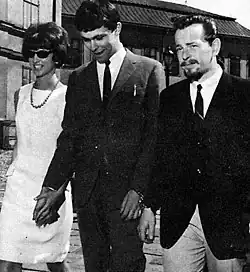Motivation and emotion/Book/2025/Stockholm syndrome emotion
What are the emotional aspects of Stockholm syndrome?
|
(3 min)] |
Overview
|
Something catchy about paradox of empathy/compassion/gratitude alongside fear/terror/isolation/abuse.  Comment on complexity of human behaviour, why? Chapter will unpack:
|
|
Focus questions:
|
Stockholm syndrome
Stockholm syndrome is complex adaptive response to traumatic and threatening situations

Definition:
- Origins: Norrmalmstorg robbery- Hyper link other cases i.e Patty Hearst,
- Differentiation from disorder (why?) - comment, prior to DSM V consideration of inclusion under other stress related condition
- Brief comment on need for language - title to change to reflect survival mechanism (discus later on)
What are the emotional aspect of Stockholm sydrome?
Topic sentence
Sub heading one
Para one
Para two
Para three
Sub heading two
Para one
Para two
Para three
Para four
Sub heading three
Para one
Para two
Para three
Para four
Table 1.
The Title of the table
| Likely to list emotions and definitions | Heading |
|---|---|
| Terror (?) | Explanation |
| Gratitude (?) | Explanation |
| Sympathy or Empathy (?) | Explanation |
| Fear (?) | Explanation |
| Explanation |
Test yourself
| REVIEW QUIZ |
Psychological mechanisms
Topic sentence (Brief): Survival
Sub heading one
Para one
Para two
Para three
|
Case study
insert a case study example that illustrates how positive affect/sympathy w. ones capture can be a mechanism of survival - i.e decrease threat level and increase provision of needs |
Sub heading two
Para one
Contemporary Approaches (critque)
Topic sentence (Brief):
Appeasement
Critique
Feminist/DV/FV - against use of term
Other critque
Test yourself
| REVIEW HOW TO DO QUIZ |
Conclusion
See also
- Trauma bonding (Wikipedia)
- Attachment theories (Wikipedia)
- Stockholm syndrome and motivation (Book chapter, 2024)
Reference
Bailey, R., Dugard, J., Smith, S. F., & Porges, S. W. (2023). Appeasement: replacing Stockholm syndrome as a definition of a survival strategy. European Journal of Psychotraumatology, 14(1). https://doi.org/10.1080/20008066.2022.2161038
Cantor, C., & Price, J. (2007). Traumatic entrapment, appeasement and complex post-traumatic stress disorder: Evolutionary perspectives of hostage reactions, domestic abuse and the Stockholm syndrome. The Australian and New Zealand Journal of Psychiatry, 41(5), 377–384. https://doi.org/10.1080/00048670701261178
Hammack, S. E., Cooper, M. A., & Lezak, K. R. (2012). Overlapping neurobiology of learned helplessness and conditioned defeat: Implications for PTSD and mood disorders. Neuropharmacology, 62(2), 565–575. https://doi.org/10.1016/j.neuropharm.2011.02.024
Music, G. (2021). Resparking from flatness: new thoughts on shut-down states after trauma and neglect. Journal of Child Psychotherapy, 47(3), 357–375. https://doi.org/10.1080/0075417X.2021.2018482
Palker-Corell, A., & Marcus, D. K. (2004). Partner abuse, learned helplessness, and trauma symptoms. Journal of Social and Clinical Psychology, 23(4), 445–462. https://doi.org/10.1521/jscp.23.4.445.40311
External links
- What is Stockholm syndrome (YouTube)